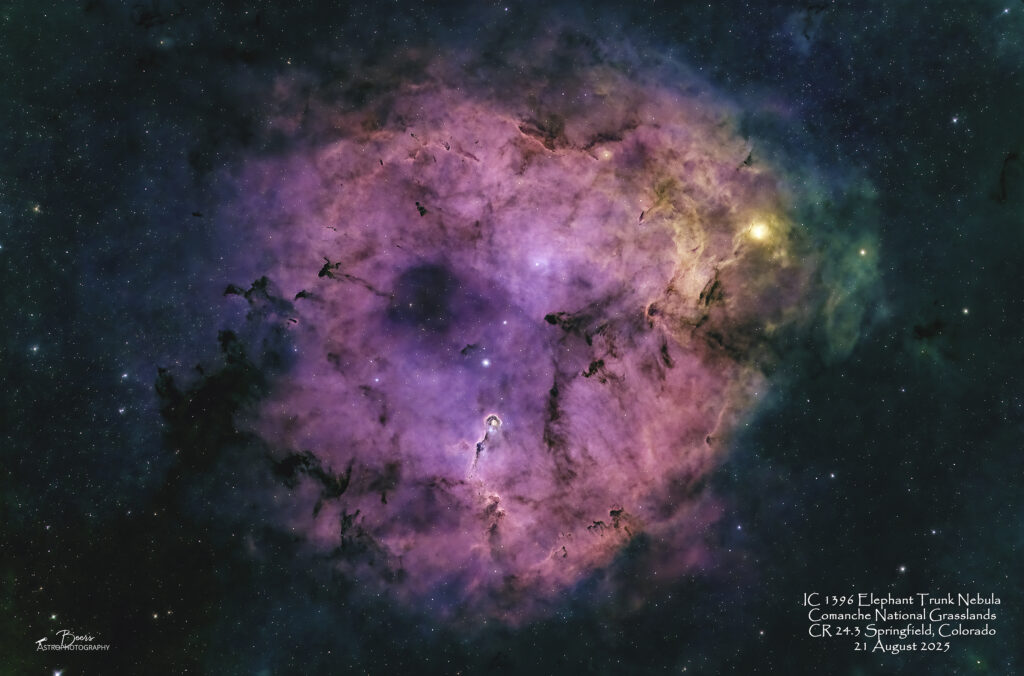
Target Fun Facts
The Elephant’s Trunk Nebula is a concentration of interstellar gas and dust within the much larger ionized gas region IC 1396 located in the constellation Cepheus about 2,400 light years away from Earth. The dense globule piece of the nebula is IC 1396A; it is commonly called the Elephant’s Trunk nebula because of its appearance at visible light wavelengths, where there is a dark patch with a bright, sinuous rim. The bright rim is the surface of the dense cloud that is being illuminated and ionized by a very bright, massive star (HD 206267) that is just to the east of IC 1396A. The entire IC 1396 region is ionized by the massive star, except for dense globules that can protect themselves from the star’s harsh ultraviolet rays. The large and relatively faint emission nebula IC 1396 is more than 100 light years across. The star responsible for its glow is the blue multiple star system HD 206267. The Elephant’s Trunk itself stretches over a region of 20 light years.
The Elephant’s Trunk Nebula is now thought to be a site of star formation, containing several very young (less than 100,000 yr) stars that were discovered in infrared images in 2003. Two older (but still young, a couple of million years, by the standards of stars, which live for billions of years) stars are present in a small, circular cavity in the head of the globule. Winds from these young stars may have emptied the cavity.
The combined action of the light from the massive star ionizing and compressing the rim of the cloud, and the wind from the young stars shifting gas from the center outward lead to very high compression in the Elephant’s Trunk Nebula. This pressure has triggered the current generation of protostars.
{From: https://en.wikipedia.org/wiki/Elephant%27s_Trunk_Nebula and https://www.constellation-guide.com/elephants-trunk-nebula }
Other Catalog Designations: The Misty Clover Cluster, SH2-131, LBN451, Cr439, Ced195
Subtype: Cluster associated with nebulosity
Distance from Earth: 2400 light years
Size: 100 light years (emission nebula), 20 light years (trunk length)
Magnitude: 3.50
Constellation: Cepheus
Capture & Processing Notes
This image was captured from Springfield, Colorado. Specifically, from Comanche National Grasslands public land on a spot about half a mile south of US Hwy 160 off County Road 24.3. The trip was a hybrid dark skies (staying in a hotel in Springfield because of the 100 degree heat) and an anniversary trip to Albuquerque for dinner at dinner at Sal’s – exactly as we did in 2023. We took the Expedition rather than the Beast since we were going to be doing a lot of driving. I’d originally planned to capture a new target – B144 Fish on a Platter – but when we got to the imaging spot to check it out after arriving in Springfield during the early afternoon, I was reminded of the windmill adjacent to the point where I was planning to image. B144 was going to require a 2-tile mosaic that set below 15° at about 0515MDT. I was concerned the windmill was going to cause an issue as the target set and I was going to have to get up for the meridian flip and the mosaic’s tile switch – so I decided I would save the Fish for another time and spend the night imaging IC1396 Elephant Trunk. IC1396 (even more so with the addition of the 0.7x reducer in my FRA600’s imaging stream) only required a single frame and was going to be high in the sky all night long.
Apparently, the Elephant Trunk has become my go-to target (unintentionally) during imaging from the Comanche National Grasslands! I had imaged IC1396 from this same spot in 2023, but I had forgotten to bring the correct attachment ring for my autoguider, so I didn’t capture the best data that night. I’d forgotten that I had also imaged IC1396 during our October 2024 dark skies trip to Picture Canyon in the Comanche National Grasslands. The 2023 and 2024 versions are shown below – surprisingly, not looking too much different. Guess I should “move on” to other “late summer” targets, eh?
I got to the spot, after we’d had our anniversary dinner at the Longhorn Steakhouse (the only restaurant in town!) at about 1830, set up the Southern Cross. Once I was set up and ready to go, I had about 30 minutes to spare before it was dark enough to get started with polar alignment and imaging. Everything went very smoothly – I started the polar alignment at about 20:15MDT and was done by 20:18MDT (gotta love Polaris!) and I had everything aligned and focused with the sequence capturing its first image at 20:39MDT. I imaged IC1396 all night long, conducting the meridian flip at about 00:35-00:42, capturing images until about 20 minutes into Nautical Twilight (which I subsequently marked as “BAD” for too much light). Lesson re-learned: end the sequence at the beginning of Astronomical Twilight (Nighttime end) without straying into Nautical Twilight to save the time capturing subframes you’ll throw away!
Sequence plan: Gain 158, Offset 30, Temp 0°C; 94x5min. Captured 21Aug2025, 2039MDT – 22Aug2025, 0519MDT. (Four frames marked BAD at end of sequence, 22Aug2025, 0459 – 0519MDT)
Processing: Sequence planned and captured in SGPro, stacked in APP (Adaptive Airy Disc), star removal with Starnet++, processing with LR/PS
Equipment
All equipment controlled by HP Probook running Sequence Generator Pro v4.4.1.1441.
Imaging (ASI2400-SC w 0.7x reducer): ZWO ASI2400MC imaging camera on Askar FRA600 108mm f/5.6 Quintuplet Petzval Flat-Field Astrograph (Southern Cross) with Askar f/3.9 Full Frame Reducer for FRA600
Mount: Rainbow Astro RST-135E (controlled by iHubo ASCOM driver)
Polar alignment: QHYCCD camera (controlled by Polemaster for polar alignment)
Autoguiding: Orion 60mm Multi-Use Guide Scope with Orion StarShoot AutoGuider Pro Mono Astrophotography Camera (controlled by PHD2)
Auto Focuser: ZWO EAF Electronic Automatic Focuser – Standard (EAF-5V-STD)
Summary
Sequence plan: Gain 158, Offset 30, Temp 0°C; 94x5min. Captured 21Aug2025, 2039MDT – 22Aug2025, 0519MDT. (Four frames marked BAD at end of sequence, 22Aug2025, 0459 – 0519MDT)
Shooting location: Comanche National Grasslands’ CR 24.3 Springfield, Colorado
Equipment: Southern Cross with 0.7x Reducer
Processing: Captured in SGP, stacked in APP (Adaptive Airy Disc), star removal with Starnet++, processing with LR/PS
Other images of IC1396 Elephant Trunk Nebula:
IC1396 Elephant Trunk – Comanche National Grasslands Picture Canyon – October 2024
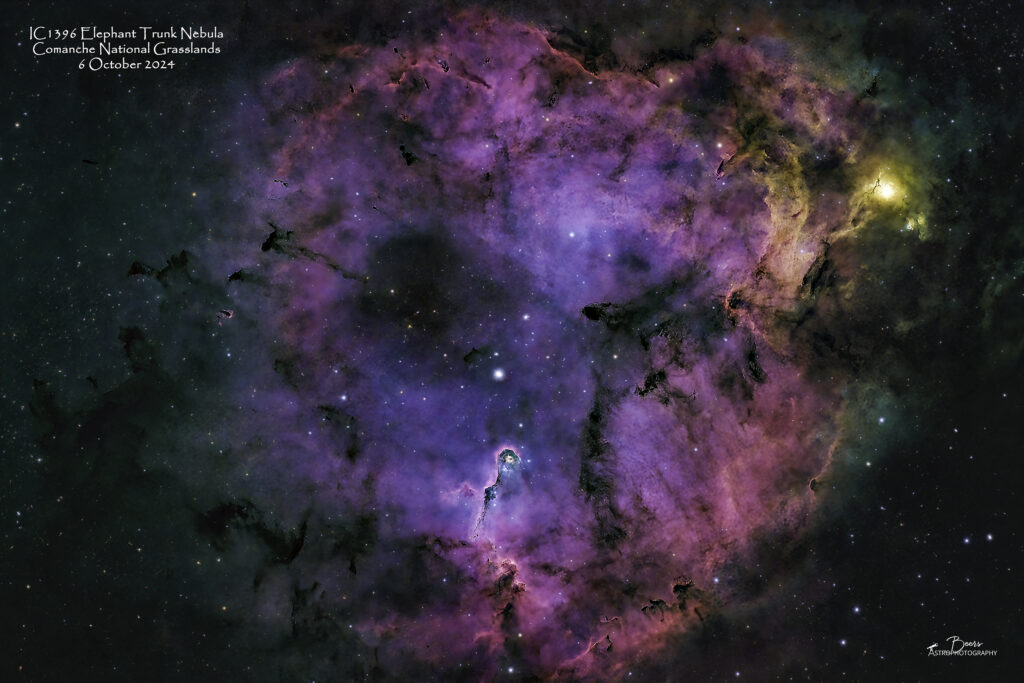
Capture Notes
Apparently, IC1396 Elephant Trunk has become the Comanche National Grassland’s favorite target! This image was captured as the first target for the Southern Cross on our second night at the Comanche National Grasslands Camel Rock camping site during our October 2024 dark skies trip.
The second night of imaging during our October 2024 dark skies trip to Comanche National Grasslands was much calmer, both wind-wise and being prepared to start imaging. On Sunday morning, in going through the power issues I had with Paul (the real/practical electrical engineer in the family), he told me how sensitive DC is to slight perturbations. The wind or not inserting and turning the cigarette lighter connection to make sure it is secure could have been the root cause of my issues on Saturday night. So I made sure to do that for Sunday night’s imaging (of course, there was no wind)…intentionally inserting the DC power cable and twisting it until it made firm contact with the female end of the cigarette lighter connection coming from the vehicle battery. That proved to do the trick to have that power source work flawlessly throughout the night.
I discovered when I polar aligned the equipment on the second night, that both rigs were out of alignment more than the settling overnight would account for – so I corrected that issue during the polar alignment process on Sunday night. Low and behold, the autoguider performance (and resulting images) was MUCH better throughout the night.
After I got the polar alignment done, I seamlessly switched to starting the sequence and had it started and capturing its first image by 19:33MDT. It collected flawlessly until it was time to switch to the night’s second target on 7Oct2024, 00:27MDT.
Equipment
Equipment: All equipment controlled by HP Probook running Sequence Generator Pro v4.4.1.1441.
Autoguiding: Orion 60mm Multi-Use Guide Scope with Orion StarShoot AutoGuider Pro Mono Astrophotography Camera (controlled by PHD2)
Imaging (ASI2400-SC): ZWO ASI2400MC imaging camera on (Southern Cross) Askar FRA600 108mm f/5.6 Quintuplet Petzval Flat-Field Astrograph
Autofocuser: ZWO EAF Electronic Automatic Focuser (EAF-5V-STD)
Mount: Rainbow Astro RST-135E (controlled by iHubo ASCOM driver)
Polar alignment: QHYCCD camera (controlled by Polemaster for polar alignment)
Sequence Plan
(6Oct2024): Gain: 158, Temp: -0°C, offset=30. 50x300sec. Total: 250 minutes (4:10 hours). Captured 6Oct2024, 19:33MDT – 7Oct2024, 00:27MDT.
IC1396 Elephant Trunk – Comanche National Grasslands CR24.3 Springfield – August 2023
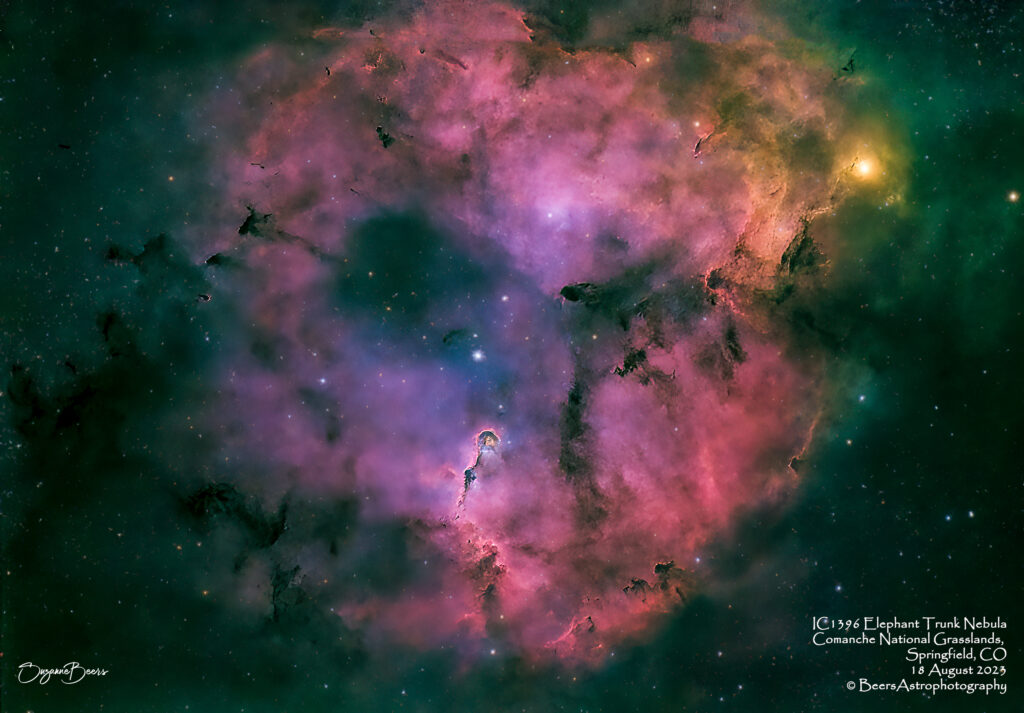
Capture Notes
This image was captured from Springfield, Colorado. Specifically, from Comanche National Grasslands public land on a spot about half a mile south of US Hwy 160 off County Road 24.3. The trip was a hybrid dark skies (staying in a hotel in Springfield because of the 100 degree heat) and an anniversary trip to Albuquerque for dinner at dinner at Sal’s. We took the Expedition (rather than the Beast since we were going to be doing a lot of driving) and in packing my gear, I decided to take only one guide scope to save space in the Pelican case optics box for my Milky Way lens and camera. Of course, in doing that, I took out the guide scope that has the attachment mount to the Southern Cross. So, the imaging was done throughout the night without a guide scope. Because I didn’t have the correct autoguider I abandoned the original plan to capture more dark skies data on Flying Bat and instead decided to capture the Elephant Trunk, a relatively bright target (Mag = 3.5). Because I had been experimenting with 2×2 binning, having read that it basically has the same effect as doubling the exposure value, I decided to use that setting. I forgot to set the camera gain before starting the sequence, so it defaulted to gain=158, no offset. I imaged from approximately 2100 until the meridian flip at approximately 0100. (Captured the Milky Way with the Canon EOS Ra with 14mm lens on the star tracker, while the Elephant Trunk capture was proceeding.) While my initial plan was to image the Elephant Trunk all night long, I decided late in the game (about the time I was going to do the meridian flip) to maximize the dark skies targets captured during this one-night trip and switched to the Flaming Skull Nebula at that point. Although I captured almost 4 hours of data, because of the lack of an autoguider, the stacking process had me deleting more than half in order to register and produce an image. In short, I captured 78×3 minute exposures (3:54hrs), the image below is a stack of 35×3 minute exposures (1:45hrs). Even given the lack of data – the richness of the colors and the ease of processing reemphasizes the fact that dark skies ARE better!
Equipment
Polar alignment: QHYCCD camera (controlled by Polemaster)
Imaging stream: (Southern Cross) Askar FRA600 on Rainbow Astro RC-135E, ZWO ASI2400MC camera
Mount: Rainbow Astro RC-135E (controlled by iHubo ASCOM driver)
All equipment controlled by HP Probook running Sequence Generator Pro v3.2.0.660.
Sequence Plan
Gain: 158, Temp: -0°C, offset=NotSet. Bin 2×2, 78x3min. Captured 18Aug2023, 2056MDT – 19Aug2023, 0057MDT. Total exposure time: 3:54hrs although due to issues with registering the subframes the image is a stack of 35×3 minute exposures (1:45hrs)
IC1396 Elephant Trunk with data captured from city skies

Capture Notes
This image was captured from the Bortle 6 skies of Colorado Springs during a 99.7% waxing gibbous moon (full moon was 1135MDT on Friday, 5May2023). The moon rose before the target and set after sunrise, so was up all night, throughout this imaging session. The imaging stream included an Optilong LeXtreme filter to counteract both the night’s natural and artificial light pollution.
Equipment
Polar alignment: QHYCCD camera (controlled by Polemaster)
Imaging stream: (Southern Cross) Askar FRA600 on Rainbow Astro RC-135E, ZWO ASI2400MC imaging camera with Optolong L-eXtreme LP filter.
Mount: Rainbow Astro RC-135E (controlled by iHubo ASCOM driver)
Autoguider: Orion 60mm Multi-Use Guide Scope, Orion StarShoot AutoGuider Pro Mono Astrophotography Camera (controlled by PHD2)
All equipment controlled by HP Probook running Sequence Generator Pro v3.2.0.660.
Sequence Plan
Gain: 158, Temp: -0°C, offset=none. SC LeX 10x5min, 25x10min. Captured 7May2023, 0001MDT – 7May2023, 0503MDT. Total exposure time: 5:00hrs (captured), 4:50hrs (in processed image).
IC1396 Multi-session image with data captured from dark and city skies
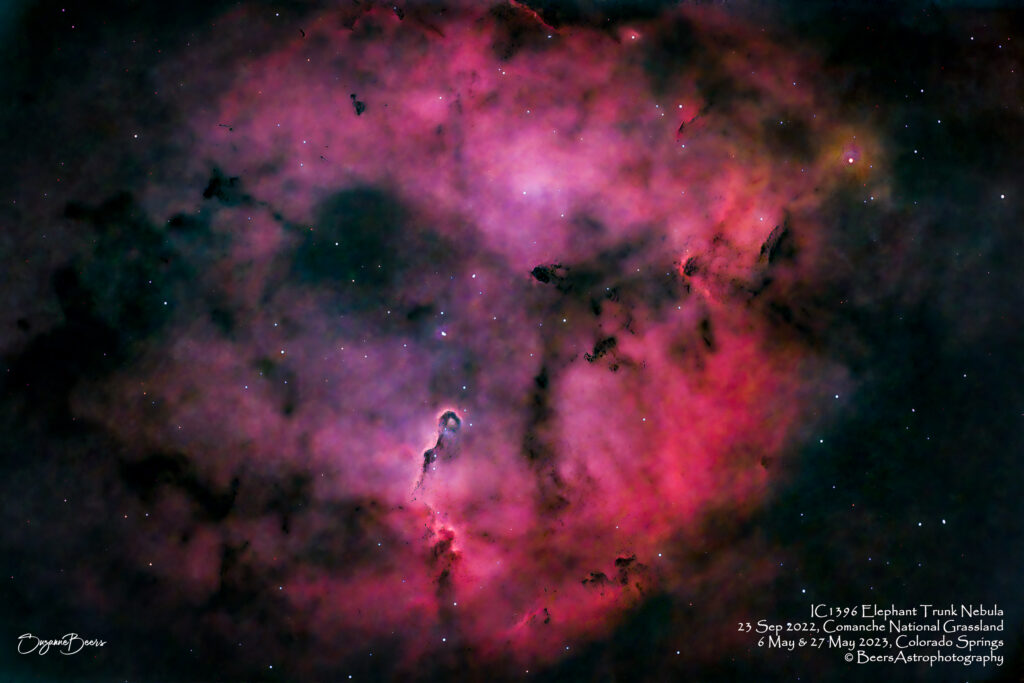
Capture Notes
This image is a combination of data from three imaging sessions. All were shot with the Askar FRA600 (600mm) telescope. On Friday, 23 September 2022 we were at Wisdom Tooth Arch in Holt Canyon of the Comanche National Grasslands for the Southern Cross’ (with the HEM27 mount) maiden voyage. Issues with the HEM27 mount limited the amount of data that could be captured during that trip. On Saturday, 6 May 2023 we had a clear night (albeit full moon), so those images were taken using the ASI2400 SC with the LeXtreme filter. Finally, on 15 May 2023 a small amount of data was captured and combined with the data captured on 27 May 2023 – both with the ASI2400 SC with the LPro filter.
Multi-session Equipment & Sequence Plans
23Sep2022:
- Equipment: iOptron Polar Scope for polar alignment; Askar FRA600 on iOptron HEM27 (controlled by iOptron Commander and ASCOM driver); Canon EOS Ra.
- Sequence Plan: ISO1600; 32x300sec; captured 24Sep2022 0305 – 0552MDT. Last four (4) subframes unusable due to too much light (after astronomical twilight start). Total exposure time: 2:40 hrs.
6May2023:
- Equipment: (Southern Cross) Askar FRA600 on Rainbow Astro RC-135E (controlled by iHubo ASCOM driver), ZWO ASI2400MC imaging camera with Optolong L-eXtreme LP filter.
- Sequence Plan: Gain: 158, Temp: -0°C, offset=none. SC LeX 10x5min, 25x10min. Captured 7May2023, 0001MDT – 7May2023, 0503MDT. During processing, deleted image captured at 0453MDT, slightly brighter than rest. Total exposure time: 5:00hrs (captured), 4:50hrs (in processed image).
15May & 27May2023:
- Equipment: (Southern Cross) Askar FRA600 on Rainbow Astro RC-135E (controlled by iHubo ASCOM driver), ZWO ASI2400MC imaging camera with Optolong L-Pro LP filter.
- Sequence Plan: 15May2023: Gain: 158, Temp: -0°C, offset=none. SC LPro 2x5min; 1x3min. Captured 15May2023, 2327-2343MDT.
- 27May2023: Gain: 158, Temp: -0°C, offset=none. SC LPro 129x3min. Captured 27May2023, 2205MDT – 28May2023, 0456MDT. During processing, deleted image captured at after 0428MDT (End of astronomical twilight, begin nautical twilight was 0427). Total exposure time: 6:27hrs (captured), 6:00hrs (in processed image).
IC1396 Elephant Trunk with data captured from dark skies – 2022
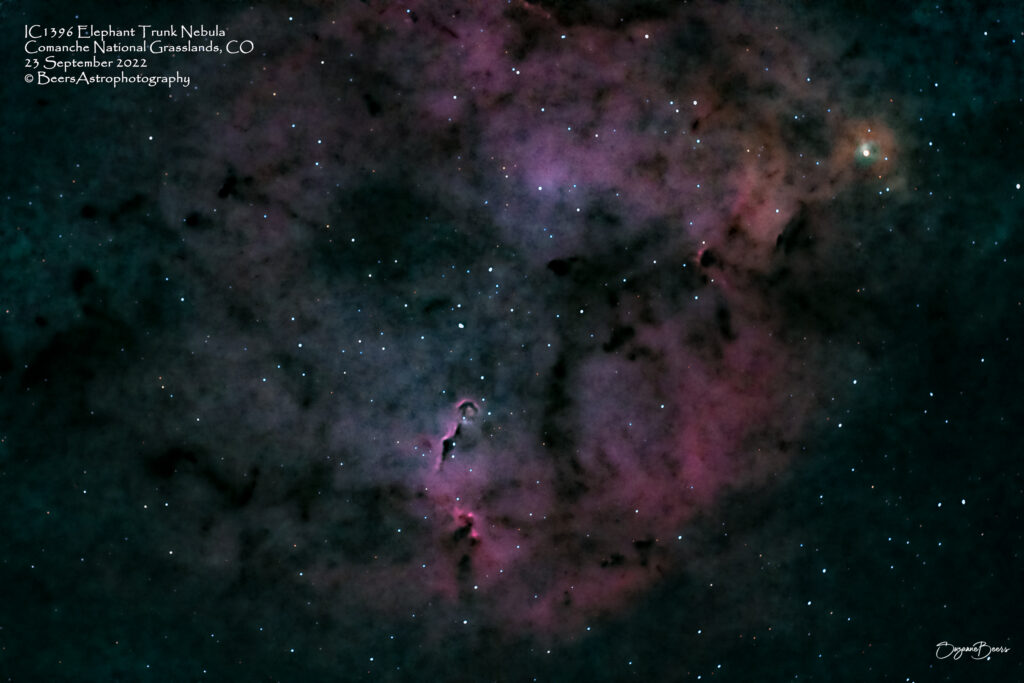
Capture Notes
This image was captured from the dark skies of the Comanche National Grasslands, during the first edition* of the Southern Cross’ (Canon EOS Ra, Askar FRA600, iOptron HEM27) maiden voyage. Arrived at Wisdom Tooth Arch and set up RaSC on HEM27, using DC power from Beast house power outlet. Polar aligned using iPolar without issue. Struggled with autoguiding calibration (errors regarding too few steps, questionable guiding), ran the PHD2 Guiding Assistant several times (recommended minimum move settings changes, applied), changed to Predictive PEC algorithm in RA. Finally got the autoguider to work, after the meridian flip (i.e., the mount will not guide when on the east side of the meridian). Autoguider worked (although with much more variation than guiding with EQ6R) because the target was well past the meridian when imaging began (azimuth = 320° – 335°).
*After another month of struggling with the iOptron HEM27 mount, I got authorization from iOptron to return it. In it’s place, I purchased a Rainbow Astro RC-135E harmonic mount which has become the mount of the Southern Cross imaging set-up (named after its intended purpose, purchased for an astrophotography workshop in Chile)
Equipment
Polar alignment: QHYCCD camera (controlled by Polemaster)
Imaging stream: Canon EOS Ra on Askar FRA600
Mount: iOptron HEM27 (controlled by iOptron Commander and ASCOM driver);
Autoguider: Orion 60mm Multi-Use Guide Scope, Orion StarShoot AutoGuider Pro Mono Astrophotography Camera (controlled by PHD2)
All equipment controlled by HP Probook running Sequence Generator Pro v3.2.0.660.
Sequence Plan
ISO1600; 32x300sec; captured 24Sep2022 0305 – 0552MDT. From Comanche National Grasslands, Colorado. Total exposure time: 2:40 hrs.
